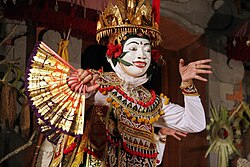Condong
 | |
| Native name | ᬘᭀᬦ᭄ᬤᭀᬂ (Balinese) Tari Condong (Indonesian) |
|---|---|
| Instrument(s) | Semar pegulingan style of gamelan |
| Inventor | Balinese |
| Origin | Indonesia |
| Condong |
|---|
|
| Burma |
| Cambodia |
| Indonesia |
|
| Laos |
| Malaysia |
| Philippines |
| Singapore |
| Thailand |
|
| Vietnam |
Condong (Balinese: ᬘᭀᬦ᭄ᬤᭀᬂ) is a Balinese dance which is often performed as a preface to legong and accompanied by the semar pangulingan style of gamelan. The term also refers to a stock character, a quintessential representation of the maidservant, found in the condong dance as well as the legong, gambuh, and arja dances.
History
[edit]
The condong dance originated in the palaces of Bali in the mid-19th century. Its creator is not known,[1] but folk history suggests that a prince of Sukawati, deathly ill, saw a vision of two beautiful girls dancing gracefully while accompanied by gamelan music; upon regaining his health, this prince recreated the dance he had seen.[2] It originally told the story of two bidadari (nymphs) named Supraba and Wilotama. By the 1930s, the story had been modified, telling of a king or queen and their subject.[1]
In current performances, the condong dancer plays the role of the subject. The choreographer Ni Ketut Arini describes the condong dancer as portraying a palace servant who both serves the king and is in awe of his power and of the beauty of the king's daughter.[2]
Many of the movements are simplified versions of the various legong dances.[2] Hence, condong is considered a basic Balinese dance and is learned by many children.[1]
There have been efforts to preserve the condong dance in Bali. These have included competitions in which children perform the dance for points.[1] Movements from condong have been adapted to more recent creations, including panyembrama (I Wayan Berata; 1971), which also includes legong movements.[3]
Performance
[edit]
Condong is generally used as a preface to the legong dance, and thus performed before it (although it may be dropped).[4] It may also be performed before gambuh or arja dances; the condong character is typical of all of them.[5] The condong character is also consistent throughout different stories, a quintessential representation of the maidservant who has introduced various princess characters, both Balinese and non-Balinese, including Rangkesari, Ophelia, and Miranda.[6]
In dances prefacing legong performances, the condong dancer enters the stage first, and performs her routine. The dancer is generally a young girl, and her movements take what ethnomusicologist Michael Tenzer terms a "sharp and intense" character. When the legong performance proper begins, the condong dancer may dance with the legong dancers,[4] presenting each dancer with a fan before withdrawing. The average length of a condong performance is about 15 minutes.[7] In the legong lasem form, the condong dancer returns with the wings of a raven to foretell the demise of the titular King Lasem.[8]
As with legong dances, condong is accompanied by the semar pangulingan style of gamelan.[2] This musical accompaniment takes the form of a series of short 16-beat melodies,[9] in the gegaboran metre.[10] In the condong dance performed as a preface to legong kraton, the music concludes with a shift to batel metre.[11]
See also
[edit]References
[edit]- ^ a b c d Bali Post 2007.
- ^ a b c d Kusumawati 2012.
- ^ Tanjung 2012.
- ^ a b Tenzer 2000, p. 160.
- ^ Indriasari 2013.
- ^ Rubin & Sedana 2007, p. 95.
- ^ Tenzer 2000, p. 357.
- ^ Tenzer 2000, p. 191.
- ^ Tenzer 2000, pp. 160, 357.
- ^ Tenzer 2000, p. 292.
- ^ Tenzer 2000, p. 293.
Works cited
[edit]- Indriasari, Lusiana (5 January 2013). "Ni Ketut Arini, Menari adalah Pengabdian" [For Ni Ketut Arini, Dance is Devotion]. Kompas (in Indonesian). Archived from the original on 9 November 2014. Retrieved 8 November 2014.
- Kusumawati, Utami Diah (23 December 2012). "Tari Legong Condong, yang Klasik dan Antik" [The Legong Condong Dance, Classic and Antique]. Jurnal Nasional (in Indonesian). Archived from the original on 9 November 2014. Retrieved 8 November 2014.
- Rubin, Leon; Sedana, I Nyoman (2007). Performance in Bali. Theatres of the world. New York: Routledge. ISBN 978-0-415-33131-9.
- "Tari Condong Dipastikan Lestari di Bali" [The Condong Dance will be Maintained in Bali]. Bali Post (in Indonesian). 12 March 2007. Archived from the original on 25 March 2014. Retrieved 8 November 2014.
- Tanjung, Intan (7 October 2012). "Stories within dances". The Jakarta Post. Archived from the original on 9 November 2014. Retrieved 8 November 2014.
- Tenzer, Michael (2000). Gamelan Gong Kebyar: The Art of Twentieth-century Balinese Music. Chicago studies in ethnomusicology. Chicago: University of Chicago Press. ISBN 978-0-226-79281-1.
External links
[edit] Media related to Condong at Wikimedia Commons
Media related to Condong at Wikimedia Commons







